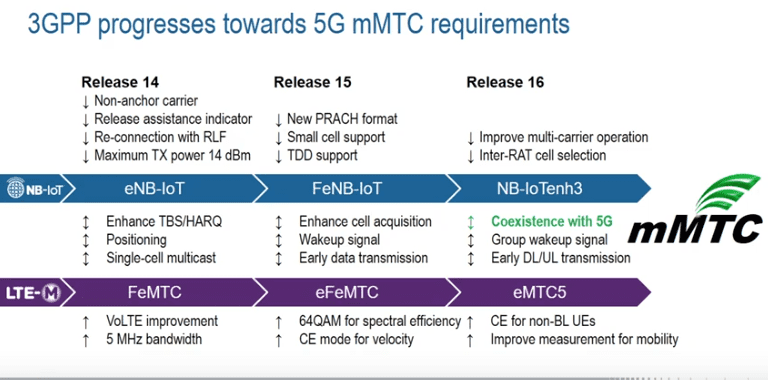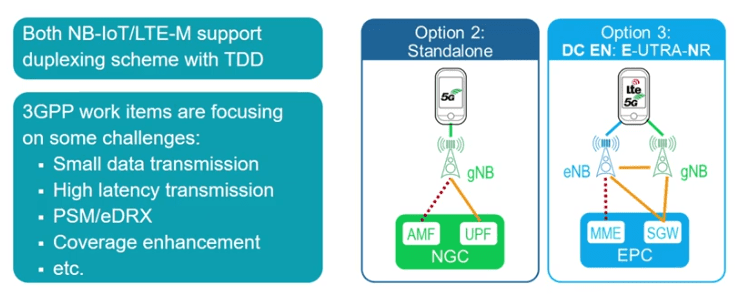The cellular IoT ecosystem, the cellular community would have us believe, is growing fast. The GSMA counted 89 NB-IoT networks and 34 LTE-M launches as of October 2019, with several operators running both technologies in tandem, at doubling in 12 months.
The number of NB-IoT and LTE-M devices and subscriptions are also growing; up 34 per cent and 70 per cent on a year ago, respectively, according to estimates from the GSA and Berg Insight. The ecosystem around new cellular IoT is gathering pace, it would appear.
“The market is there; it is very promising,” comments Jörg Kopp, market segment manager for IoT at Rohde & Schwarz, in an instructional video (embedded below) that prompted this article.
But 5G is here (or #5GisHere, as the mar-comms from Qualcomm’s latest 5G Summit has it). The question is what does the arrival of 5G – and specifically, the arrival of 5G-specified ‘massive machine-type-communications’ (mMTC) – mean for enterprises with brand new cellular IoT services.
The answer is only that they are ahead of the game – if indeed cellular-based IoT is the right game. Their NB-IoT and LTE-M networks are forwards-compatible with incoming 5G technologies, and are indeed specified originally to serve mMTC-banded IoT applications. But there is confusion, as discussion in industry circles keeps returning to the imminent arrival of 5G-era mMTC.
This should be cleared up, here, with the help of some experts, including Rohde & Schwarz. The confusion, we should state upfront, is only that NB-IoT and LTE-M, as low-power wide-area (LPWA) technologies for the kind of elemental IoT services that will constitute the great mass of the IoT market, preempt mMTC in the 5G ‘new radio’ (NR) specifications.
And these 5G NR specifications are still developing, and will bring new capabilities to existing NB-IoT and LTE-M services as they fold into 5G networks. LTE-M (LTE for machine-type communications) and NB-IoT (narrowband IoT) were introduced as new cellular LPWA standards by 3GPP in Release 13 of the LTE standard, back in 2015.

Even as 5G starts to roll out variously as an enhanced mobile broadband (eMBB) service, like a go-faster version of LTE, it continues to be defined and refined, currently as part of 3GPP’s Release 16, which sets out a third pillar for 5G NR besides: ultra-reliable low-latency communications (URLLC) for critical services and, crucially, for high-end industrial applications. URLLC is for another discussion.

But in-between 3GPP releases have effectively specified NB-IoT and LTE-M as 5G forerunners for mMTC. So what’s the difference? What changes with mMTC in 5G NR? Let’s go back, briefly, to the beginning (?).
The International Telecoms Union (ITU) said five years ago that a new mMTC standard, to be started in Release 13, was required to serve the explosion in IoT services with cellular networks. These requirements were five-fold, and have come to underpin the fundamental characteristics of sundry LPWA technologies.
The terms remain that mMTC networks enable the following: battery life of 10 years; coverage penetration of 164 dB with throughput of 160 bits per second; coverage density to support of up to a million devices in a square kilometre; round-trip latencies of less than 10 seconds with payloads of 20 bytes; and, crucially for massive scale, ultra-low cost hardware.
A sixth requirement was also defined: that these networks should support more features and applications in time, including positioning, mobility, multicast communications, and time division duplexing (TDD), where the uplink is separated from downlink by the allocation of different time slots in the same frequency band.
NB-IoT and LTE-M, based on LTE network standards, were established to serve these ends. They have been refined in Releases 14 and 15 to accommodate the ITU’s final, constantly-evolving requirement.
Feng Xie, IoT segment manager at Rohde & Schwarz explains in the video that the maximum transmission power for NB-IoT, for example, has been fixed at 14 dBm, and techniques like wake-up signalling and early data transmissions have also been wrapped into the standard.
Release 16, in the works, and sets out the template for NB-IoT and LTE-M to co-exist in 5G NR networks. “NB-IoT and LTE-M as deployed today are part of the 5G family,” says the GSMA in a white paper.
The GSMA says: “5G NR was designed to support diverse deployment models, spectrum usage and device capabilities. One of the deployment scenarios that is supported from the start of 5G NR work in 3GPP is to allow LTE-M and NB-IoT transmissions to be placed directly into a 5G NR frequency band.”
In the physical layer, as Zie explains, this coexistence is already worked out: NB-IoT and LTE-M use 15 kHz sub-carriers, as per LTE, and 5G NR defines any sub-carrier in a doubling sequence from 15 kHz to 240 kHz.
The twin cellular LPWA technologies have a similar structure in the time domain, too. In IoT, a slot is specified as 0.5 ms, a sub-frame is 1ms, and a frame is 10ms; in 5G NR, the sub-frame and frame are consistent with the LTE timings, and the slot affords more flexibility anyway.
“In the physical layer, they use a similar structure, as defined also in 5G NR. There is no problem that those technologies will work together in the same network. There will be no conflict between them,” says Zie.
There is more work in the core network and at the system level, however. TDD mode, important in 5G NR, has been defined already for NB-IoT and LTE-M, prior to Release 16.
The problem is, says Zie, the existing architecture for the 5G core network is geared towards eMBB, which puts the highest priority on throughout, and contradicts the requirements of mMTC, which prioritises other power-limiting functions such as high-latency communication, power save mode (PSM), and extended discontinuous reception (eDRX).

But Release 16 is a work in progress, and these extant coexistence issues are being addressed. “The target is to make sure coming 5G networks can support both the eMBB and mMTC requirements,” says Xie.
Gus Vos, chief engineer for technology standards at Sierra Wireless, zooms out and sums up. “When NB-IoT and LTE-M were designed, special attention was given to make sure they operate in-band with an LTE system so that the LTE spectrum can be shared. The same is possible with 5G NR, where special attention was given to the design of 5G NR to make certain NB-IoT and LTE-M can operate in-band to an NR system,” he writes in a blog post.
“3G UMTS and 4G LTE technologies use different core networks, which creates additional complexity and costs that drive operators to deprecate 3G technologies to get to a single core network. The same issue is not true for the newly specified 5G core network, which can connect to 5G NR as well as 5G LTE.”
And so, we find, mMTC, this cornerstone (with eMBB and URLLC) of 5G, has been set down already in LTE with NB-IoT and LTE-M, but will be made stronger with the arrival of new 5G NR specifications. The point for enterprises, seeking to deploy cellular IoT solutions, is to carry on building with NB-IoT and LTE-M in the knowledge the arrival of 5G will not undermine their efforts to run their own machine-type comms.
Says Vos: “5G will offer several new capabilities that could disrupt many markets, but it’s important to understand that, for IoT applications, the revolution – in the form of LTE-M and NB-IoT – is already here; it’s future proof and will be supported for many years to come with 5G and is thus clearly on the path to 5G.”
